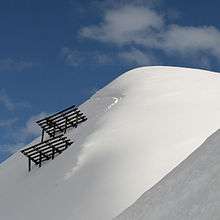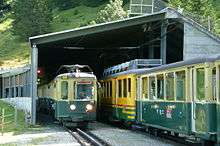Snow shed

A snow shed, snow bridge or avalanche gallery is a type of rigid snow-supporting structure for avalanche control (avalanche defense) or to maintain passage in areas where snow removal becomes almost impossible. They can be made of steel, prestressed concrete frames, or timber.[1][2] These structures can be fully enclosed, like an artificial tunnel, or consist of lattice-like elements. They are typically of robust construction considering the environments they must survive in.
Snow protection is particularly important when routes cross avalanche "chutes", which are natural ravines or other formations that direct or concentrate avalanches.

Snow sheds or avalanche galleries are a common sight on railroads in mountain areas, such as the Donner Pass in the United States or many of the Swiss mountain railways, where tracks are covered with miles of shedding. Although unused today, the Central Pacific railroad had a complete rail yard under roof in the pass. They are also found on especially hazardous stretches of roadway as well. The Trans-Canada Highway between Revelstoke and Golden in British Columbia has several snow sheds covering both carriageways to cope with the heavy snow.
East of Snoqualmie Pass in Washington in the northwest U.S., westbound Interstate 90 had a snow shed midway along the east shore of Keechelus Lake (47°21′18″N 121°21′57″W / 47.355°N 121.3658°W, milepost 57.7); it was removed in 2014 in preparation for the construction of bridges to replace it.[3][4] The 500-foot (150 m) concrete structure covered two lanes on a curve and was constructed in 1950 for U.S. Route 10, then one lane in each direction; it marked the first time precast construction was used for a highway structure in a mountainous area and was the last remaining snow shed on an Interstate highway.[5]
Snow bridge
Snow bridges may superficially look similar to snow fences, but they act differently. Snow fences are built vertically and accumulate snow on their downwind side, while snow bridges are slanted or horizontal and hold snow on their top side.
Snow bridges are fastened to the slope on the upslope side by tension anchors and on the downslope by compression anchors.[6]
See also
References
- ↑ Photographs of avalanche defences, FAO corporate document repository
- ↑ FAO, Staff. "Avalanche and torrent control in the Spanish Pyrenees". National Forests Organization of Spain. Patrimonio Forestal del Estado. Retrieved 2016-12-01.
- ↑ McFadden, Meagan; Smith, Jason (March 13, 2013). "New bridges get green light to replace snowshed east of Snoqualmie Pass". State of Washington. Department of Transportation. Retrieved June 21, 2017.
- ↑ "I-90 Snowshed Removal Time Lapse". YouTube. Washington State Department of Transportation. April 16, 2016. Retrieved June 21, 2017.
- ↑ Derrey, Summer (March 18, 2014). "The I-90 Snowshed Retires After 64 Years!". WSDOTBlog.BlogSpot.com. Retrieved June 21, 2017.
- ↑ "Steel snow bridges"
External links
